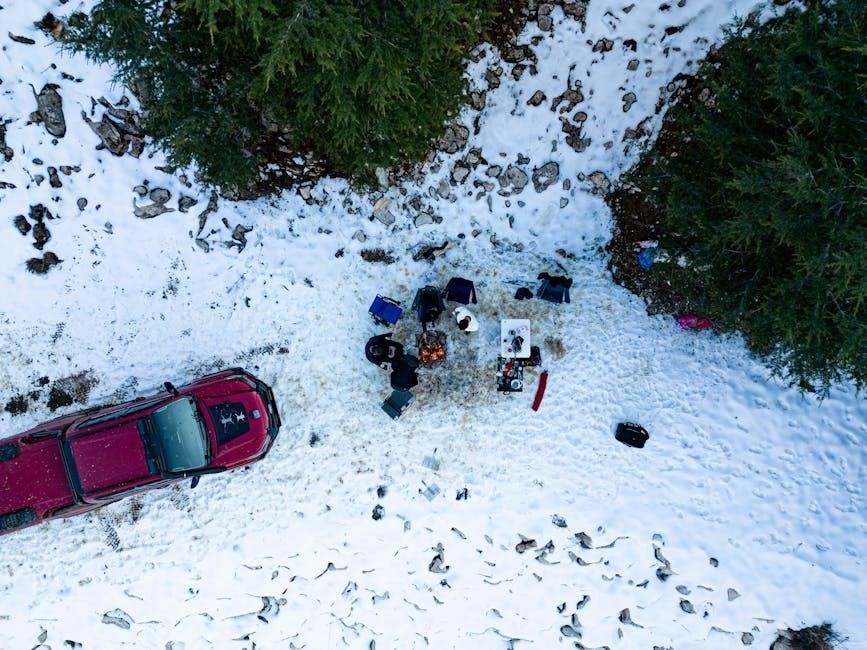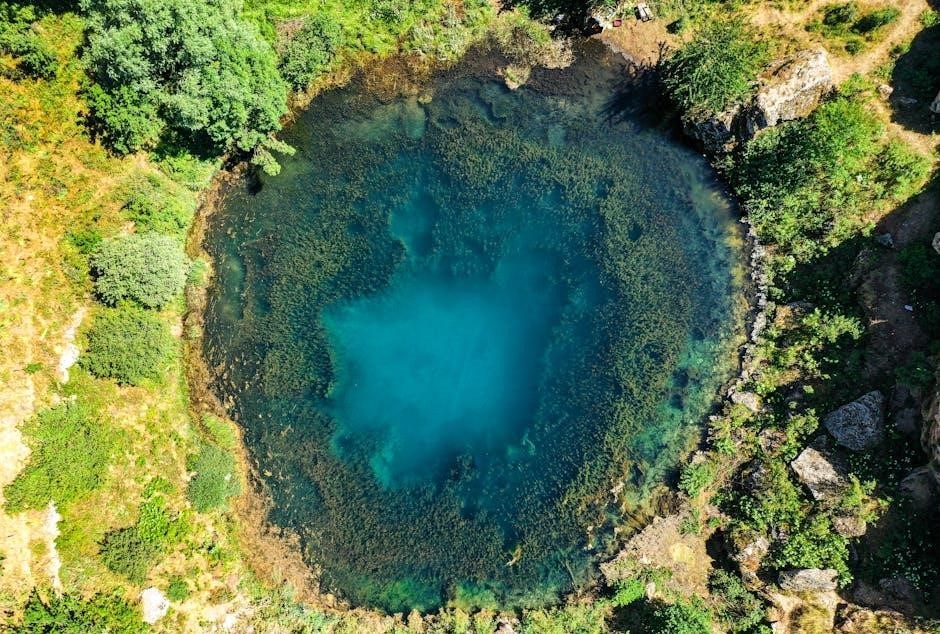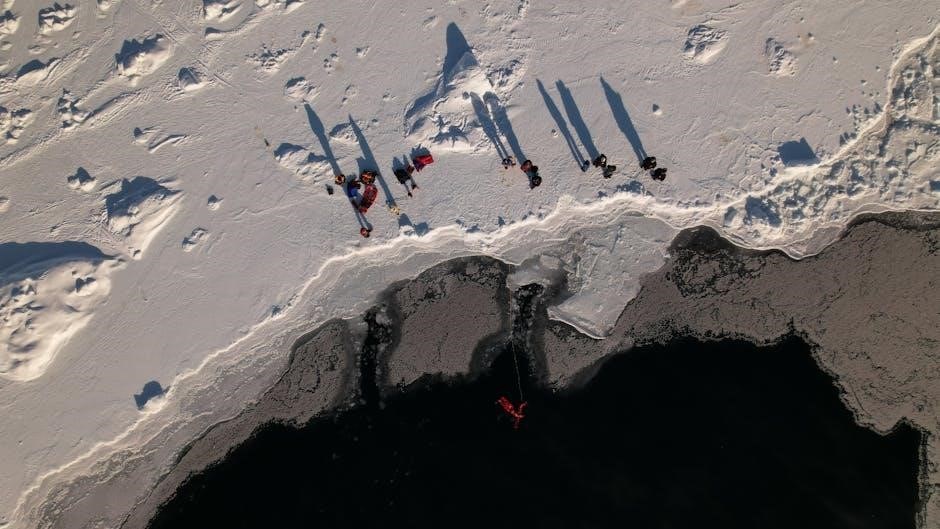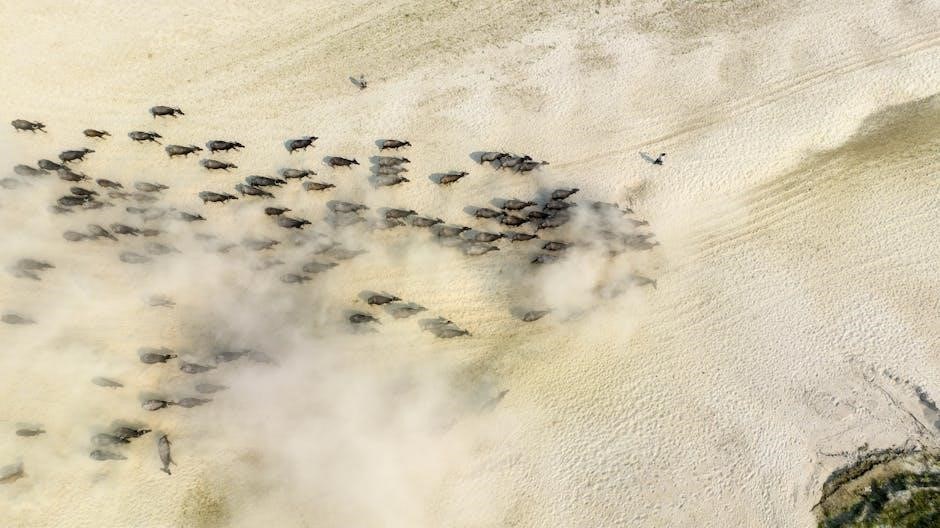Welcome to the Drone Survival Guide, your ultimate resource for mastering drone flight. This guide covers essential tips, safety measures, and emergency preparedness to ensure a seamless experience.

Choosing the Right Drone
Selecting the right drone involves considering your skill level, purpose, and budget. From beginner-friendly models to advanced FPV or industrial drones, choose one that matches your needs and ensures safe, enjoyable flights.
2.1. Drones for Beginners
If you’re new to drone flying, drones for beginners are the perfect starting point. These models are designed with simplicity and durability in mind, making them ideal for learning the basics. Look for drones with features like one-key takeoff, altitude hold, and emergency landing buttons to minimize crashes. Budget-friendly options often include basic cameras, while mid-range models may offer better stability and longer flight times. Brands like DJI and Holy Stone provide excellent beginner drones with robust build quality and user-friendly controls. Always consider your skill level and intended use when selecting a drone, ensuring it aligns with your needs for safe and enjoyable flying experiences.
2.2. FPV Drones
FPV drones offer an immersive flying experience through first-person view technology. These drones are equipped with cameras that transmit live video to goggles or screens, allowing pilots to feel as though they’re inside the aircraft. Ideal for racing and aerial photography, FPV drones require a higher level of skill due to their focus on real-time feedback and precise control. Beginners should start with models that include features like stabilization modes to ease the learning curve. Advanced pilots can opt for high-speed FPV drones with customizable components. Always ensure compliance with local regulations when flying FPV drones, as they often require specific permits and operational guidelines to maintain safety and legal adherence.
2.3. Industrial Drones

Industrial drones are designed for commercial and professional applications, offering advanced capabilities for tasks like surveying, inspection, and delivery. These drones are built with durability and precision in mind, often equipped with specialized sensors and cameras for high-accuracy data collection. Unlike recreational models, industrial drones require professional operation and adherence to strict safety and legal standards. They are widely used in industries such as agriculture, construction, and public safety. With their robust design and extended flight capabilities, industrial drones are essential tools for businesses seeking efficient solutions. Proper training and maintenance are crucial to ensure optimal performance and safety in demanding environments.
Drone Safety Guidelines
Ensure safe drone operations by following guidelines like maintaining line of sight, avoiding obstacles, and respecting airspace restrictions. Always inspect equipment and adhere to local regulations;
3.1. Pre-Flight Checks
Conducting thorough pre-flight checks is crucial for ensuring a safe and successful drone operation. Start by inspecting the drone for any physical damage, paying attention to the propellers, motors, and frame. Verify that all components are securely attached and functioning properly. Next, check the battery health, ensuring it is fully charged and free from damage. Review the weather conditions to avoid flying in strong winds, heavy rain, or extreme temperatures. Additionally, ensure the remote controller is paired correctly and all sticks and buttons are responsive. Finally, confirm that the drone’s GPS and compass are calibrated, and that the firmware is up to date. Always refer to the manufacturer’s guidelines for specific pre-flight procedures and adhere to local aviation laws to minimize risks and ensure a smooth flight experience.
3.2. Flying in Different Weather Conditions
Flying a drone in various weather conditions requires careful consideration to ensure safety and performance. Always check the weather forecast before flying and avoid strong winds, as they can destabilize the drone. Heavy rain or snow should be avoided, as moisture can damage the electronics. Extreme temperatures, whether hot or cold, can affect battery life and motor efficiency. For optimal performance, fly in calm, clear conditions with temperatures between 32°F and 104°F (0°C to 40°C). Additionally, avoid flying near thunderstorms, as lightning poses a significant risk. Be cautious of humidity, as high levels can interfere with electronic components. By understanding and adapting to these conditions, you can ensure a safer and more enjoyable flight experience.
3.3. Legal Considerations
Flying a drone comes with significant legal responsibilities to ensure safety and compliance with regulations. In many countries, drone registration is mandatory for devices exceeding a certain weight. Always research and obtain necessary permits before flying in restricted areas, such as near airports or government buildings. Adhere to altitude limits and maintain a safe distance from people and property. Additionally, respect privacy laws by avoiding unauthorized surveillance or photography. Familiarize yourself with local aviation rules and update your knowledge as regulations evolve. Failure to comply can result in fines or legal action. Stay informed and fly responsibly to enjoy this technology while respecting legal boundaries.
3.4. Emergency Preparedness
Being prepared for emergencies is crucial when flying a drone. Always have a recovery plan in case of a crash or system failure. Understand your drone’s failsafe settings, which can automatically land the device or return it to you if signal is lost. Keep a first-aid kit and a backup battery on hand. In case of a lost drone, use GPS tracking if available and report the incident to local authorities. Familiarize yourself with emergency landing techniques to minimize damage. Additionally, stay informed about natural disaster preparedness, such as storing your drone safely during extreme weather. Knowing how to handle emergencies ensures safer flights and protects your investment. Always prioritize caution and quick thinking to mitigate risks effectively.

Understanding Drone Components
Drone components include batteries, motors, propellers, and cameras. Each part plays a vital role in flight performance, efficiency, and durability. Understanding these components ensures optimal functionality and safe operation.
4.1. Drone Batteries
Drone batteries are crucial for flight performance and longevity. Most drones use Lithium-Polymer (LiPo) batteries, known for high energy density and reliability. Battery life varies, with beginner drones lasting around 10 minutes, while advanced models can fly up to 60 minutes. Proper care is essential: avoid extreme temperatures, prevent overcharging, and store batteries at 50% capacity when not in use. Always check for damage before flights and ensure compatibility with your drone. Understanding battery health and maintenance ensures safer, more efficient flights. Regularly monitoring voltage and discharge rates helps extend lifespan. A well-maintained battery enhances overall drone performance and reliability, making it a key component for any pilot.
4;2. Propellers
Propellers are essential for drone flight, providing lift and stability. They come in various sizes and materials, with plastic being ideal for beginners due to durability, while carbon fiber offers higher efficiency for advanced models. Proper installation and balance are critical to avoid vibrations and ensure smooth operation. Regularly inspect propellers for damage or wear, as damaged blades can compromise flight performance and safety. Cleaning propellers after flights prevents debris buildup, which can affect aerodynamics. Always store propellers securely to avoid bending or breaking. Choosing the right propeller size and type for your drone enhances performance, efficiency, and overall flying experience. Maintaining and upgrading propellers is a key part of drone ownership and optimization.
4.3. Motors
Motors are a critical component of drones, driving the propellers to generate thrust. Most drones use brushless motors for their high efficiency and durability. Motor size and KV rating (revolutions per volt) determine performance, with higher KV motors offering more speed but lower efficiency. Proper cooling is essential to prevent overheating, which can reduce motor lifespan. Regular maintenance, such as cleaning dust from motors, ensures optimal performance. Upgrading motors can enhance flight capabilities but requires balancing with propeller size and ESC settings. Always choose motors compatible with your drone’s frame and battery for reliable operation. Efficient motor performance directly impacts flight time, stability, and overall drone functionality, making them a vital part of your drone’s system.
4.4. Cameras
Cameras are a key feature of modern drones, enabling aerial photography, videography, and surveillance. Most drones come with built-in cameras, while others allow for external mounts. Resolution, field of view (FOV), and stabilization are critical factors for capturing high-quality footage. Gimbal-stabilized cameras reduce vibration and ensure smooth video. For beginners, cameras with automatic settings are ideal, while professionals may prefer manual controls. Consider storage capacity and ensure your drone supports high-speed memory cards. FPV cameras provide real-time video feedback, enhancing flight control. Always check local regulations regarding camera use and privacy concerns. Proper camera setup and calibration are essential for optimal performance. Regularly clean and maintain lenses to avoid damage. Choose a camera that aligns with your needs for recreational or professional use, ensuring crisp and clear imagery every time.

Drone Flight Techniques
Mastering drone flight techniques requires practice and patience. Start with basic maneuvers like hovering and gradual turns. Advanced techniques include orbiting and tracking. Always prioritize safety.
5.1. Basic Flight Maneuvers
Mastering basic flight maneuvers is the foundation of drone piloting. Start with hovering, ensuring the drone remains steady at a low altitude. Practice forward, backward, and lateral movements by gently adjusting the sticks. Learn to ascend and descend smoothly using the throttle. Familiarize yourself with yaw control for rotation and pitch for tilting. These maneuvers build coordination and confidence. Always begin in an open, obstacle-free area to minimize risks. Gradually increase speed as you gain control. Remember, smooth inputs are key to avoiding sudden movements. Regular practice will refine your skills, making advanced techniques more accessible. Safety and patience are paramount during this learning phase.
5.2. Advanced Flight Tips
Once comfortable with basic maneuvers, explore advanced flight techniques to elevate your piloting skills. Practice smooth transitions between movements for fluidity. Use GPS mode for stability in windy conditions and enable obstacle avoidance systems to prevent collisions. Master dynamic tracking by following moving subjects with precision. Experiment with orbiting and spiral climbs to capture stunning aerial footage. Understanding your drone’s physics, such as thrust and torque, enhances control. Regularly practice in varied environments to adapt to different challenges. These tips refine your expertise, ensuring safe and creative flights. Remember, advanced techniques require patience and consistent practice to master effectively.
5.3. Orbiting and Tracking
Orbiting and tracking are advanced techniques that enhance your drone’s ability to capture dynamic footage. Orbiting involves flying your drone in a circular path around a subject, creating a seamless, 360-degree view. Tracking requires the drone to follow a moving subject, maintaining focus while adapting to its speed and direction. Both techniques are ideal for cinematography and surveillance. To master these, use GPS and waypoint navigation for precision. Ensure smooth transitions by gradually adjusting altitude and speed. Practice tracking stationary objects before moving to dynamic subjects. These methods add depth and professionalism to your aerial operations, making them indispensable for creative and practical applications alike. Regular practice will refine your control and consistency in executing these maneuvers effectively.
Maintenance and Repairs

Regular maintenance ensures optimal drone performance. Clean propellers, check battery health, and inspect for wear. Address repairs promptly to prevent further damage and ensure safe flights.
6.1. Routine Maintenance
Regular maintenance is crucial for ensuring your drone operates efficiently and safely. Start by inspecting the propellers for damage or debris—clean them gently and ensure they’re securely attached. Next, check the battery health by monitoring its voltage and storage conditions. Store batteries in a cool, dry place to prevent degradation. Additionally, review the drone’s firmware and update it to the latest version for optimal performance. Use a soft cloth to clean the camera lens and body, avoiding harsh chemicals. Finally, inspect the motors for dust buildup and ensure all connections are secure. Routine checks help prevent malfunctions and extend your drone’s lifespan. By staying proactive, you can enjoy smoother flights and reduce the risk of unexpected issues.
6.2. Common Repairs
Drone repairs often involve addressing damage to propellers, which can crack or bend upon impact. Replace damaged propellers immediately to maintain balance and performance. Battery issues, such as swelling or poor connections, are also common—inspect and replace batteries if necessary. Motor repairs may involve cleaning dust buildup or replacing faulty units. Additionally, check the drone’s frame for loose screws or cracks, tightening or replacing parts as needed. For camera repairs, ensure the lens is clean and free of damage. Regularly inspect and replace worn-out components like landing gear or gimbals. Always use original or compatible parts for repairs to ensure reliability. By addressing these common issues promptly, you can extend your drone’s lifespan and maintain optimal functionality. Proper repair practices are essential for safe and efficient drone operation.
6.3. Software Updates
Regular software updates are crucial for maintaining your drone’s performance, safety, and compatibility. Manufacturers often release updates to fix bugs, enhance features, and improve security. Always check the official website or app for the latest firmware versions. Before updating, ensure your drone and controller are fully charged. Follow the step-by-step instructions provided by the manufacturer to avoid errors. After updating, restart your drone and controller to apply changes. Keep your remote controller and drone firmware synchronized for seamless operation. Updating software ensures optimal functionality, better flight stability, and access to new features. Never use third-party software, as it may void warranties or compromise your drone’s security. Regular updates are key to a reliable and enjoyable flying experience. Stay informed about new releases to keep your drone up-to-date and performing at its best.
Handling Drone Emergencies
The Drone Survival Guide provides essential tips for navigating emergencies like system failures, crashes, or natural disasters. Stay prepared with recovery techniques and safety measures to ensure safe outcomes.
7.1. What to Do in Case of a Crash
If your drone crashes, remain calm and follow these steps. First, ensure everyone’s safety and check for injuries. Avoid touching electrical components immediately. Inspect the drone for damage, focusing on propellers, motors, and the battery. Disconnect the battery to prevent short circuits or fires. Document the incident for insurance or repair purposes. Store the drone in a dry, cool place to prevent further damage. Contact the manufacturer or a professional for repairs. Avoid flying the drone again until it’s fully inspected and cleared. Always keep a backup drone or essential parts on hand. Remember, crashes are learning opportunities to improve your flying skills and safety measures.
7.2. System Failures
System failures during drone operation can be critical, requiring immediate action. If a motor fails, land the drone safely and disconnect the battery to prevent further damage. Check for loose connections or debris obstructing components. GPS failures may cause navigation issues, so switch to manual mode and fly cautiously. Always carry a backup battery and essential tools. Regular maintenance, such as updating software and cleaning sensors, can prevent failures. Document the incident for warranty claims or repairs. Practice emergency landing techniques to ensure readiness. Stay calm and prioritize safety above all. Remember, system failures are rare but manageable with proper preparation and knowledge.
7.3. Lost or Stolen Drone
If your drone is lost or stolen, act quickly to minimize loss. Use GPS tracking features to locate it if equipped. Contact local authorities and report the incident with serial number and last-known location. Check nearby areas and review flight logs for clues. Secure your drone with a lock when not in use and keep it in sight during flights. Consider drone insurance for theft or loss coverage. Document the incident for potential claims. Always backup flight data and personal settings. Stay vigilant and report any suspicious activity. Remember, prevention is key—ensure your drone is well-secured and tracked at all times. Stay informed and prepared to handle such situations effectively.
7.4. Natural Disaster Preparedness
Natural disasters like earthquakes, hurricanes, or floods can pose significant risks to your drone and its operation. Always secure your drone in a safe, dry location during extreme weather. Use waterproof cases or bags to protect your equipment from moisture and debris. Keep backup batteries and a portable charger handy in case of power outages. Stay informed about weather alerts and avoid flying in hazardous conditions. After a disaster, inspect your drone for damage before flight and avoid areas with debris or unstable structures. Follow local guidelines for drone use in disaster zones, as authorities may restrict airspace. Be prepared to assist in recovery efforts responsibly, ensuring safety and compliance with regulations. Proper preparation and caution are key to safeguarding your drone and using it effectively during crises.

Drone Survival Checklist
The Drone Survival Checklist provides essential pre-flight, during flight, and post-flight procedures to ensure safety, efficiency, and preparedness for all drone operations.
8.1. Pre-Flight Checklist
A thorough pre-flight checklist is crucial to ensure safe and successful drone operations. Begin by verifying battery health and ensuring all components are securely connected. Check the propellers for damage and proper installation. Calibrate the drone’s compass and GPS system for accurate navigation. Review local weather conditions and ensure the flying area is clear of obstacles. Familiarize yourself with legal restrictions, such as no-fly zones and altitude limits. Conduct a quick systems test, including the remote controller and camera functionality. Finally, plan your flight path and set boundaries to avoid losing signal or running out of battery. A well-executed pre-flight routine minimizes risks and enhances your flying experience.
8.2. During Flight Checklist
During flight, maintain a clear line of sight with your drone to ensure control and awareness of surroundings. Continuously monitor battery levels and estimate remaining flight time. Avoid obstacles by adjusting altitude or trajectory as needed. Stay alert to changing weather conditions, such as wind or rain, which can affect stability. Keep the remote controller securely in hand and avoid distractions. Use built-in features like Return-to-Home to retrieve the drone if needed. Avoid flying over restricted zones or sensitive areas. Be mindful of nearby people or animals to prevent accidents. Adjust speed and altitude based on the environment and mission requirements. Plan for a safe landing by scouting a clear area and descending gradually. Stay within legal altitude limits and maintain communication with the drone at all times.
8.3. Post-Flight Checklist
After landing, inspect the drone for any visible damage or wear. Ensure all components, including propellers and cameras, are secure and undamaged. Disconnect the battery and store it in a cool, dry place, away from direct sunlight. Review the flight data to ensure all objectives were met and to identify areas for improvement. Clean the drone, removing dirt or debris that may interfere with future flights. Store the drone and accessories in a protective case to prevent damage. Charge the battery only when necessary and avoid overcharging. Log the flight in a maintenance record to track usage and plan future maintenance. Finally, ensure all safety protocols were followed and document any issues encountered during the flight for future reference.
The Drone Survival Guide has provided you with a comprehensive roadmap to mastering drone flight, from basic tips to advanced techniques. By following this guide, you can ensure safe, efficient, and enjoyable drone operations. Whether you’re a beginner or a seasoned pilot, understanding safety protocols, emergency preparedness, and maintenance routines is crucial for maximizing your drone’s potential. Remember, practice makes perfect, and staying informed about the latest trends and regulations will keep you ahead. Use this guide as your go-to resource for every flight, and always prioritize safety to make the most of your drone experience. Happy flying!
